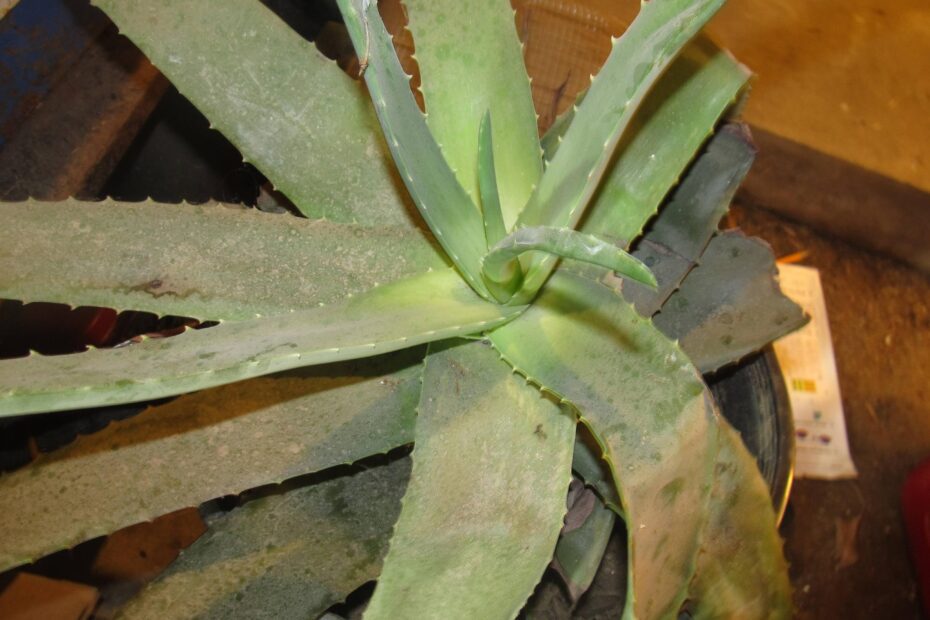The Enigma Unveiled: A Pearly Mystery Surrounding Your Aloe Plant
In the enchanting world of houseplants, each leafy companion has its own captivating tale to tell. The aloes, with their succulent allure and soothing remedies, have always been revered as nature’s little marvels in our indoor sanctuaries. However, even the most seasoned plant whisperers may find themselves confounded when faced with an inexplicable transformation. Are we simply witnessing botanical magic or an insidious phenomenon lurking beneath the surface? Today, we embark on a quest to unlock the enigma behind that peculiar sight haunting the minds of plant enthusiasts worldwide: “Why is my aloe plant turning white?” Prepare to unravel the delicate threads of this mystery as we explore the various aspects that might be casting this ethereal pale cloak upon your green companion.
Potential Causes of White Aloe Plants
White aloe plants can be a cause for concern, as they are typically known for their vibrant green color. Several potential causes can contribute to aloe plants turning white. One possibility is sunburn. Aloe plants are naturally hardy and can thrive in bright, indirect sunlight. However, if exposed to direct sunlight for an extended period, their leaves can become bleached and turn white.
Another explanation for white aloe plants could be stress due to underwatering or overwatering. Aloe plants require well-drained soil and should be watered thoroughly but infrequently. If they are not receiving enough water, their leaves may lose their green pigmentation and turn white. On the other hand, overwatering can lead to root rot and nutrient deficiencies, which also results in pale leaves.
To prevent your aloe plant from turning white, consider implementing the following features and tips:
| Provide proper lighting | Avoid exposing your aloe plant to direct sunlight. Instead, place it in bright, indirect light. |
| Adjust watering routine | Ensure your aloe plant’s soil is well-drained and water it thoroughly when the top inch of soil feels dry. Avoid overwatering or underwatering. |
| Maintain ideal temperature | Aloe plants prefer temperatures between 55-80°F (13-27°C). Avoid exposing them to extreme heat or cold, as it can cause stress. |
Remember, keeping your aloe plant healthy and happy involves finding the perfect balance of light, water, and care. By addressing potential causes and implementing proper care techniques, you can help ensure your aloe plant retains its vibrant green color, leaving you with a beautiful and thriving addition to your indoor or outdoor space.

Understanding Sunburn on Aloe Leaves
Sunburn on aloe leaves can be a common issue faced by many plant enthusiasts, often leaving them puzzled and concerned. This phenomenon, where the leaves of your beloved aloe plant turn white, is a result of excessive exposure to sunlight. Aloe plants are native to arid climates and are accustomed to bright but indirect light. When subjected to intense sunlight for extended periods, the leaves can become scorched, resulting in a white or pale appearance.
While it may be alarming to see your aloe plant’s leaves losing their vibrant green color, rest assured that sunburn is typically a temporary condition that can be addressed with proper care. Here are a few features and tips to help you understand and alleviate sunburn on your aloe leaves:
| Features | Tips |
|---|---|
| Red or Brown Spots: | Trim off any damaged leaves and provide your aloe plant with shade or indirect sunlight until it recovers. |
| Soft or Mushy Texture: | Ensure proper drainage in the pot to prevent overwatering, as soggy soil can exacerbate sunburned leaves. |
| Crispy or Brittle Leaves: | Water your aloe plant thoroughly but infrequently, allowing the soil to dry out between waterings. |
Remember, prevention is always better than cure when it comes to sunburn on aloe leaves. To shield your aloe plant from the scorching rays of the sun, consider providing it with a light shade cloth or relocating it to a spot with indirect light. Additionally, adjusting the amount of time your plant spends in direct sunlight can help prevent sunburn. By being mindful of your aloe plant’s light requirements and taking necessary precautions, you can preserve the health and beauty of its leaves for years to come.
Identifying and Treating Fungal Infections in Aloe Plants
One common issue that aloe plant owners may encounter is when their beloved green succulent starts to take on a pale, white appearance. This sudden change in color can be quite alarming and may indicate the presence of a fungal infection. Fungal infections in aloe plants can be caused by a variety of factors, such as overwatering, poor drainage, or unsanitary conditions. These infections can weaken the plant and lead to further health complications if not addressed promptly.
To identify and treat fungal infections in your aloe plant, it’s important to first observe the affected areas. Look for white or gray spots on the leaves or near the base of the plant. These spots may gradually spread and cause the leaves to become discolored or wilted. Additionally, the affected areas may have a musty smell or feel damp to the touch. If you notice any of these signs, it’s crucial to take immediate action before the infection worsens.
There are several effective ways to treat fungal infections in aloe plants. Firstly, ensure that your plant is placed in a location with ample sunlight and good air circulation. This will help prevent the growth of fungus and aid in the plant’s overall health. Secondly, adjust your watering habits. Overwatering can create a moist environment that is favorable for fungal growth, so be sure to let the soil dry out completely between waterings. Additionally, consider using a well-draining soil mix and a container with adequate drainage holes to prevent waterlogged roots. Lastly, remove any infected leaves or parts of the plant using sterilized pruning shears to prevent the spread of the fungus. Treat the remaining healthy parts with a fungicidal spray or a homemade solution of diluted neem oil to combat the infection effectively.
Below is a helpful table that provides some features and tips on .
| Feature | Tips |
|---|---|
| Discolored leaves | Inspect for white or gray spots, wilted or yellowing leaves |
| Musty smell | Check for a damp or unpleasant odor near the infected areas |
| Sufficient sunlight | Ensure the plant receives at least 6 hours of indirect sunlight daily |
Remember, early intervention is key when it comes to treating fungal infections in aloe plants. By promptly identifying the signs and implementing the appropriate measures, you can help restore your plant’s health and prevent the further spread of infection. Keep a close eye on your aloe plant, take proactive steps to maintain its hygiene, and be sure to provide the necessary care it needs to thrive.
Preventing and Remediating Mealybugs on Aloe Plants
Has your vibrant green aloe plant suddenly taken on a ghostly white appearance? Don’t fret, as the answer may lie in a common culprit – mealybugs. These tiny, sap-sucking insects can wreak havoc on your beloved aloe plants, causing discoloration, wilting, and even death if not addressed promptly. Fortunately, with a few preventative measures and effective remediation techniques, you can protect your aloe plants from these pesky invaders and restore their natural beauty.
To combat mealybugs on your aloe plants effectively, consider these key features:
| Features/Tips | Benefits |
|---|---|
| Natural pesticides | Safe for the plant and environment |
| Regular inspections | Early detection and prevention of infestation |
| Isolation | Prevents spread to other plants |
Remember, prevention is key when it comes to mealybugs. Regularly inspect your aloe plants for signs of infestation, such as white, cottony clusters on the leaves or wilted foliage. If mealybugs are detected, swift action is crucial. Utilize natural pesticides that are safe for your plants, application methods, and isolate the infested plant to protect others in your collection. By implementing these measures and being proactive in your approach, you can keep your aloe plants healthy and vibrant, free from the clutches of mealybugs.
Frequently Asked Questions
Q: Why is my aloe plant suddenly rocking a stylish white look?
A: Fear not, your aloe plant isn’t pulling off a mid-life crisis. The white hue could be a sign of a marvelous adaptation – sunburn protection!
Q: But wait, can aloe plants really get sunburned?
A: Absolutely! These incredible plants, native to sandy deserts, rely on their green pigmentation to shield themselves from the harsh sun. When exposed to excessive light or intense heat, they often turn white as a protective mechanism, like slipping into a trendy sunscreen outfit.
Q: Is there anything I can do to help my aloe plant regain its green fashion?
A: Fortunately, aiding your aloe plant on its path to a glorious green comeback is fairly easy. Gradually acclimating it to brighter light and providing some light shade during peak sun hours will prevent future sunburn. Also, consider checking the care routine, adjusting watering frequency, or ensuring the plant receives the correct amount of nutrients. With a little TLC, your aloe will be back to rocking its natural shade in no time! As we bid adieu to this enlightening journey into the world of aloe plants, we find ourselves marveling at the mesmerizing phenomenon of their leaves turning white. Although our avid curiosity may have sparked worry or concern, we can now rest assured, knowing that the enigmatic transition is merely nature unveiling her extraordinary palette of colors.
As the sun sets on our exploration, we have learned that aloe plants, ever the attention-seekers, often adopt a pale hue when exposed to excessive sunlight or harsh weather conditions. A striking reminder to us all that even these resilient succulents have their limits and need a little extra TLC.
But fear not, dear friends of the green thumb! We have unraveled the secrets to bringing back the coveted green glory of your aloe plant. Through the art of gentle shading, regular watering, and occasional relocation, we can coax these remarkable botanical beauties back to their natural, vibrant state.
Remember, patience and attentiveness are the key ingredients to nurturing and revitalizing our aloe companions. As we embark on our newfound journey of tending to their delicate needs, we can revel in the gratifying experience of watching them evolve into the magnificent specimens they were meant to be.
So, embrace this newfound knowledge and wield your gardening prowess with confidence. Just as these aloe plants morph from white to green, let us transform ourselves into guardians of nature’s astonishing creations. May our love for these resilient succulents inspire us to never stop seeking answers to the mysteries that surround them.
As we part ways, armed with newfound wisdom, let us continue to delve into the enchanting world of botany, marveling at its infinite wonders. For in our unwavering curiosity lies the potential to unlock nature’s most captivating secrets, one aloe plant at a time.
Farewell in this chapter, but may the skies of knowledge always remain open to us, ready to guide us on our next horticultural adventure. Until then, keep your gardens thriving, your minds inquisitive, and your souls forever tethered to the awe-inspiring realm of nature’s secrets.
- When to Put Weed and Feed on Lawn in Michigan - October 16, 2023
- When to Fertilize Potatoes Plants - October 16, 2023
- Can You Plant Clover in the Spring - October 16, 2023

